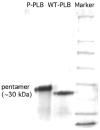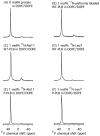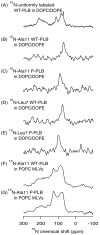(15)N Solid-state NMR spectroscopic studies on phospholamban at its phosphorylated form at ser-16 in aligned phospholipid bilayers
- PMID: 20044975
- PMCID: PMC2827642
- DOI: 10.1016/j.bbamem.2009.12.020
(15)N Solid-state NMR spectroscopic studies on phospholamban at its phosphorylated form at ser-16 in aligned phospholipid bilayers
Abstract
Wild-type phospholamban (WT-PLB) is a pentameric transmembrane protein that regulates the cardiac cycle (contraction and relaxation). From a physiological prospective, unphosphorylated WT-PLB inhibits sarcoplasmic reticulum ATPase activity; whereas, its phosphorylated form relieves the inhibition in a mechanism that is not completely understood. In this study, site-specifically (15)N-Ala-11- and (15)N-Leu-7-labeled WT-PLB and the corresponding phosphorylated forms (P-PLB) were incorporated into 1,2-dioleoyl-sn-glycero-3-phosphocholine/2-dioleoyl-sn-glycero-3-phosphoethanolamine (DOPC/DOPE) mechanically oriented lipid bilayers. The aligned (15)N-labeled Ala-11 and Leu-7 WT-PLB samples show (15)N resonance peaks at approximately 71ppm and 75ppm, respectively, while the corresponding phosphorylated forms P-PLB show (15)N peaks at 92ppm and 99ppm, respectively. These (15)N chemical shift changes upon phosphorylation are significant and in agreement with previous reports, which indicate that phosphorylation of WT-PLB at Ser-16 alters the structural properties of the cytoplasmic domain with respect to the lipid bilayers.
Published by Elsevier B.V.
Figures



Similar articles
-
The structural topology of wild-type phospholamban in oriented lipid bilayers using 15N solid-state NMR spectroscopy.Protein Sci. 2007 Nov;16(11):2345-9. doi: 10.1110/ps.072977707. Epub 2007 Sep 28. Protein Sci. 2007. PMID: 17905829 Free PMC article.
-
Side chain and backbone dynamics of phospholamban in phospholipid bilayers utilizing 2H and 15N solid-state NMR spectroscopy.Biochemistry. 2007 Oct 23;46(42):11695-706. doi: 10.1021/bi700749q. Epub 2007 Oct 2. Biochemistry. 2007. PMID: 17910421 Free PMC article.
-
Phospholamban and its phosphorylated form interact differently with lipid bilayers: a 31P, 2H, and 13C solid-state NMR spectroscopic study.Biochemistry. 2006 Nov 7;45(44):13312-22. doi: 10.1021/bi0614028. Biochemistry. 2006. PMID: 17073452 Free PMC article.
-
Direct spectroscopic detection of molecular dynamics and interactions of the calcium pump and phospholamban.Ann N Y Acad Sci. 1998 Sep 16;853:186-94. doi: 10.1111/j.1749-6632.1998.tb08266.x. Ann N Y Acad Sci. 1998. PMID: 10603946 Review.
-
Dual site phospholamban phosphorylation and its physiological relevance in the heart.Trends Cardiovasc Med. 2002 Feb;12(2):51-6. doi: 10.1016/s1050-1738(01)00145-1. Trends Cardiovasc Med. 2002. PMID: 11852250 Review.
Cited by
-
Lipid-mediated folding/unfolding of phospholamban as a regulatory mechanism for the sarcoplasmic reticulum Ca2+-ATPase.J Mol Biol. 2011 May 13;408(4):755-65. doi: 10.1016/j.jmb.2011.03.015. Epub 2011 Mar 17. J Mol Biol. 2011. PMID: 21419777 Free PMC article.
-
Structural topology of phospholamban pentamer in lipid bilayers by a hybrid solution and solid-state NMR method.Proc Natl Acad Sci U S A. 2011 May 31;108(22):9101-6. doi: 10.1073/pnas.1016535108. Epub 2011 May 16. Proc Natl Acad Sci U S A. 2011. PMID: 21576492 Free PMC article.
-
Phosphorylation and mutation of phospholamban alter physical interactions with the sarcoplasmic reticulum calcium pump.J Mol Biol. 2011 Jan 21;405(3):707-23. doi: 10.1016/j.jmb.2010.11.014. Epub 2010 Nov 23. J Mol Biol. 2011. PMID: 21108950 Free PMC article.
-
Structural dynamics and topology of phosphorylated phospholamban homopentamer reveal its role in the regulation of calcium transport.Structure. 2013 Dec 3;21(12):2119-30. doi: 10.1016/j.str.2013.09.008. Epub 2013 Oct 24. Structure. 2013. PMID: 24207128 Free PMC article.
-
Secondary structure, backbone dynamics, and structural topology of phospholamban and its phosphorylated and Arg9Cys-mutated forms in phospholipid bilayers utilizing 13C and 15N solid-state NMR spectroscopy.J Phys Chem B. 2014 Feb 27;118(8):2124-33. doi: 10.1021/jp500316s. Epub 2014 Feb 18. J Phys Chem B. 2014. PMID: 24511878 Free PMC article.
References
-
- Simmerman HKB, Jones LR. Phospholamban: protein structure, mechanism of action, and role in cardiac function. Physiol Rev. 1998;78:921–947. - PubMed
-
- Ying W, Irvine SE, Beekman RA, Siminovitch DJ, Smith SO. Deuterium NMR reveals helix packing interactions in phospholamban. J Am Chem Soc. 2000;122:11125–11128.
-
- Arkin IT, Rothman M, Ludlam CFC, Aimoto S, Engelman DM, Rothschild KJ, Smith SO. Structural model of the phospholamban ion-channel complex in phospholipid-membranes. J Mol Biol. 1995;248:824–834. - PubMed
-
- Tatulian SA, Jones LR, Reddy LG, Stokes DL, Tamm LK. Secondary structure and orientation of phospholamban reconstituted in supported bilayers from polarized attenuated total-reflection FTIR spectroscopy. Biochemistry. 1995;34:4448–4456. - PubMed
-
- Robia SL, Flohr NC, Thomas DD. Phospholamban pentamer quaternary conformation determined by in-gel fluorescence anisotropy. Biochemistry. 2005;44:4302–4311. - PubMed
Publication types
MeSH terms
Substances
Grants and funding
LinkOut - more resources
Full Text Sources

